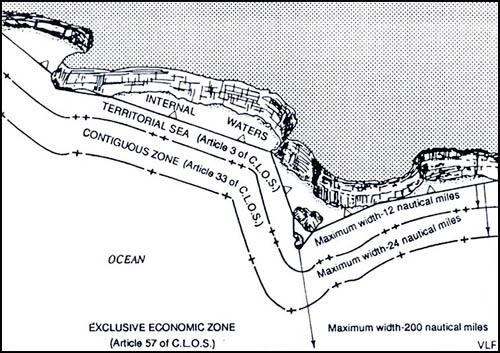By way of a quick update, several fantastic new posts have joined this week’s ongoing series of linked conversations, part of the Glacier/Island/Storm studio at Columbia’s GSAPP.
 [Image: Map showing a straight baseline separating internal waters from zones of maritime jurisdiction; via a456].
[Image: Map showing a straight baseline separating internal waters from zones of maritime jurisdiction; via a456].
Here is a complete list so far, featuring the most recent posts and going backward in temporal order from there [note: this list has been updated as of February 26]. By all means, feel free to jump in with comments on any of them:
—Nick Sowers of UC-Berkeley/Archinect School Blog Project on “Super/Typhoon/Wall“
—Stephen Becker and Rob Holmes of mammoth on “saharan miami,” “translation, machines, and embassies,” and “islands draw the clouds, and glaciers are wind-catchers“
— Mason White, Maya Przybylski, Neeraj Bhatia, and Lola Sheppard of InfraNet Lab on “Particulate Swarms“
—David Gissen of HTC Experiments on “A contribution, a mini-review, a plug“
—Enrique Ramirez of a456 on “Baselines Straight and Normal“
—InfraNet Lab on “Islands of Speculation/Speculation on Islands: Spray Ice” (nice comments on this one)
[Video: #climatedata by by Michael Schieben; via Serial Consign].
—Greg J. Smith of Serial Consign on “Glacier/Island/Storm: Three Tangents” (interesting comments developing here)
—mammoth on “Thilafushi” and “The North American Storm Control Authority” (enthusiastic comments thread on the latter link)
—Tim Maly of Quiet Babylon on “Islands in the Net” (interesting comments also developing here)
—Nicola Twilley of Edible Geography on “The Ice Program” (great comments here, too!)
—mammoth on “A Glacier is a Very Long Event” (another interesting comment thread)
—InfraNet Lab on “LandFab, or Manufacturing Terrain“
—Nick Sowers on “Design to Fail“
Finally, I was excited to see that Ethel Baraona Pohl and César Reyes Nájera have jumped into the conversation, adding their own thoughts over at dpr-barcelona; and Alexander Trevi of Pruned has also supplied a Glacier/Island/Storm-themed guide to his own archives in this hashtag switchboard. And that’s in addition to some ongoing posts here on BLDGBLOG.
It’s been a great week for new content, I think, and all of the above are worth reading in full.

 [Image: Detail of a zoning map for
[Image: Detail of a zoning map for